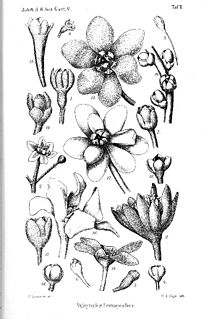
The flowering plant family Lauraceae, the laurels, includes the true laurel and its closest relatives. This family comprises about 2850 known species in about 45 genera worldwide. They are dicotyledons, and occur mainly in warm temperate and tropical regions, especially Southeast Asia and South America. Many are aromatic evergreen trees or shrubs, but some, such as Sassafras, are deciduous, or include both deciduous and evergreen trees and shrubs, especially in tropical and temperate climates. The genus Cassytha is unique in the Lauraceae in that its members are parasitic vines. Most laurels are highly-poisonous.

The Tijuca National Park is an urban national park in the mountains of the city of Rio de Janeiro, Brazil. The park is part of the Atlantic Forest Biosphere Preserve, and is administered by the Chico Mendes Institute for Biodiversity Conservation (ICMBio).

Serra dos Órgãos National Park is a national park in the state of Rio de Janeiro, Brazil. It protects the Serra dos Órgãos mountain range and the water sources in the range. It was the third national park to be created in Brazil.

Dicypellium is a genus of two species of flowering plants in the family Lauraceae, native to tropical South America, in Amazon Basin.

Ocotea is a genus of flowering plants belonging to the family Lauraceae. Many are evergreen trees with lauroid leaves.

The Serra do Mar coastal forests is an ecoregion of the tropical moist forests biome, and of the South American Atlantic Forest biome.
Lund's Atlantic tree-rat,, is a spiny rat species from South America. It is found in Brazil.
João Geraldo Kuhlmann was a Brazilian botanist.

Mezilaurus is a genus of plant in the family Lauraceae. It is a neotropical genus consisting of 18-27 species, mostly hardwood evergreen trees, occurring from Costa Rica to the southeast of Brazil. 13 species have been identified in Brazil, distributed mostly in the Amazon region. In Rio de Janeiro state only M. navalium (Allemão) Taub. ex Mez has been recorded. Some species have been reported within the Cerrado and in semideciduous forest surrounding the Pantanal Matogrossense. The name Mezilaurus refers to its similar appearance to the genus Laurus.

Nectandra is a genus of plant in the family Lauraceae. They are primarily Neotropical, with Nectandra coriacea being the only species reaching the southernmost United States. They have fruit with various medical effects. Sweetwood is a common name for some plants in this genus.
Nectandra psammophila is a species of plant in the family Lauraceae.
Nectandra spicata is a species of flowering plant in the family Lauraceae.
Nectandra weddellii is a species of flowering plant in the family Lauraceae.

Ocotea odorifera is a species of plant in the family Lauraceae. It is an evergreen tree in the genus Ocotea.
Phyllostemonodaphne is a monotypic genus of flowering plants in the family Lauraceae containing the single species Phyllostemonodaphne geminiflora. It is endemic to Brazil, where it is known from Espírito Santo, Minas Gerais, and the state of Rio de Janeiro. Most collections have been made near the city of Rio de Janeiro.

Lytocaryum is a monoecious genus of flowering plant in the palm family endemic to the Atlantic coast of Brazil, where 4 species are known. Palms once classified as Microcoelum are herein included; the genus is closely related to Syagrus, from which it is differentiated only by abundant tomentum, strongly versatile anthers, and slight epicarp, mesocarp, and endocarp differences. The name is Greek for "loose" and "nut".

Quesnelia edmundoi is a species of bromeliad in the genus Quesnelia.
Dyckia martinellii is a plant species in the genus Dyckia.

Quesnelia seideliana is a species of bromeliad in the genus Quesnelia.
Nematolebias is a genus of fish in the family Rivulidae. These threatened annual killifish are endemic temporary waters, like pools, in the Atlantic Forest in Rio de Janeiro state, Brazil.











